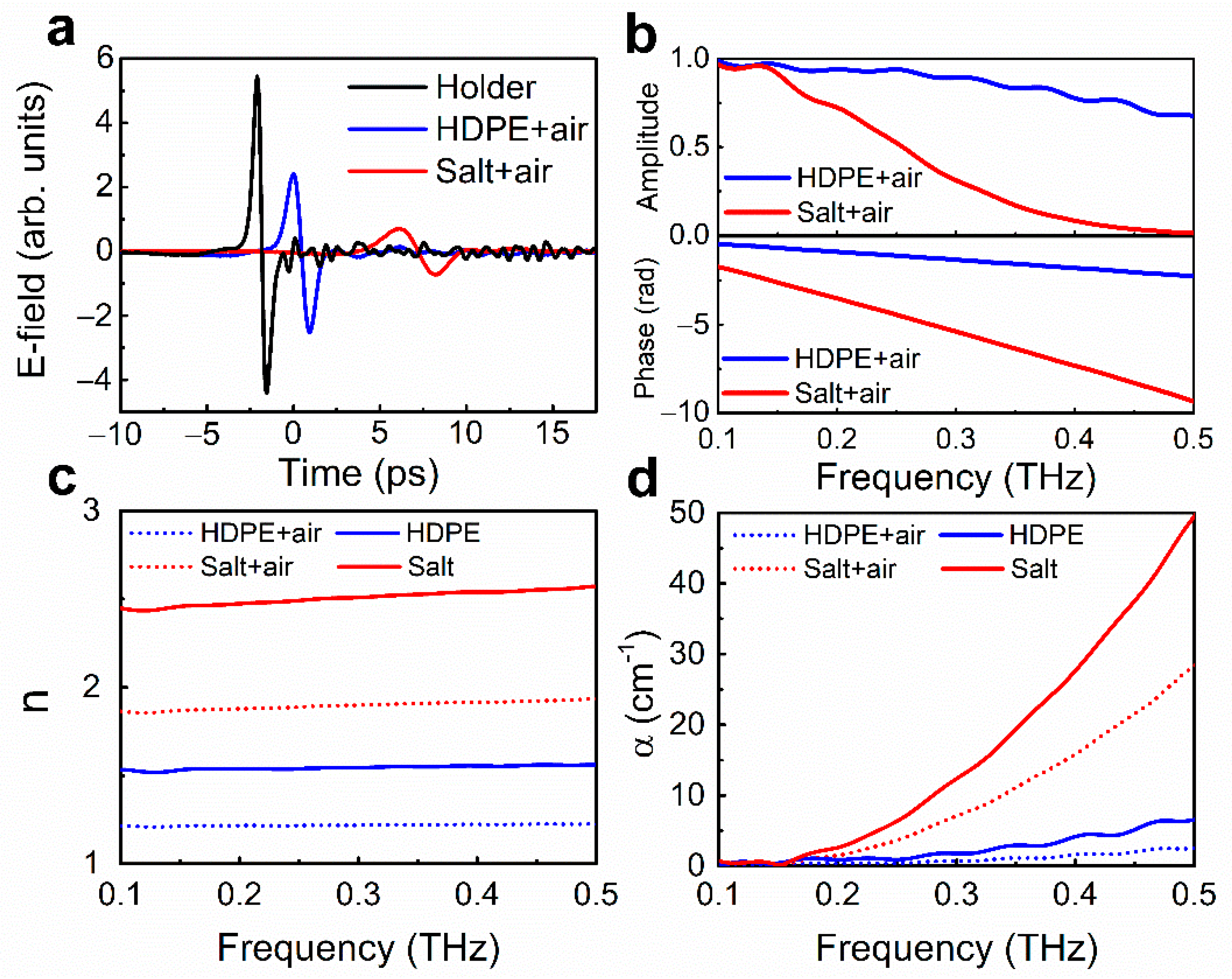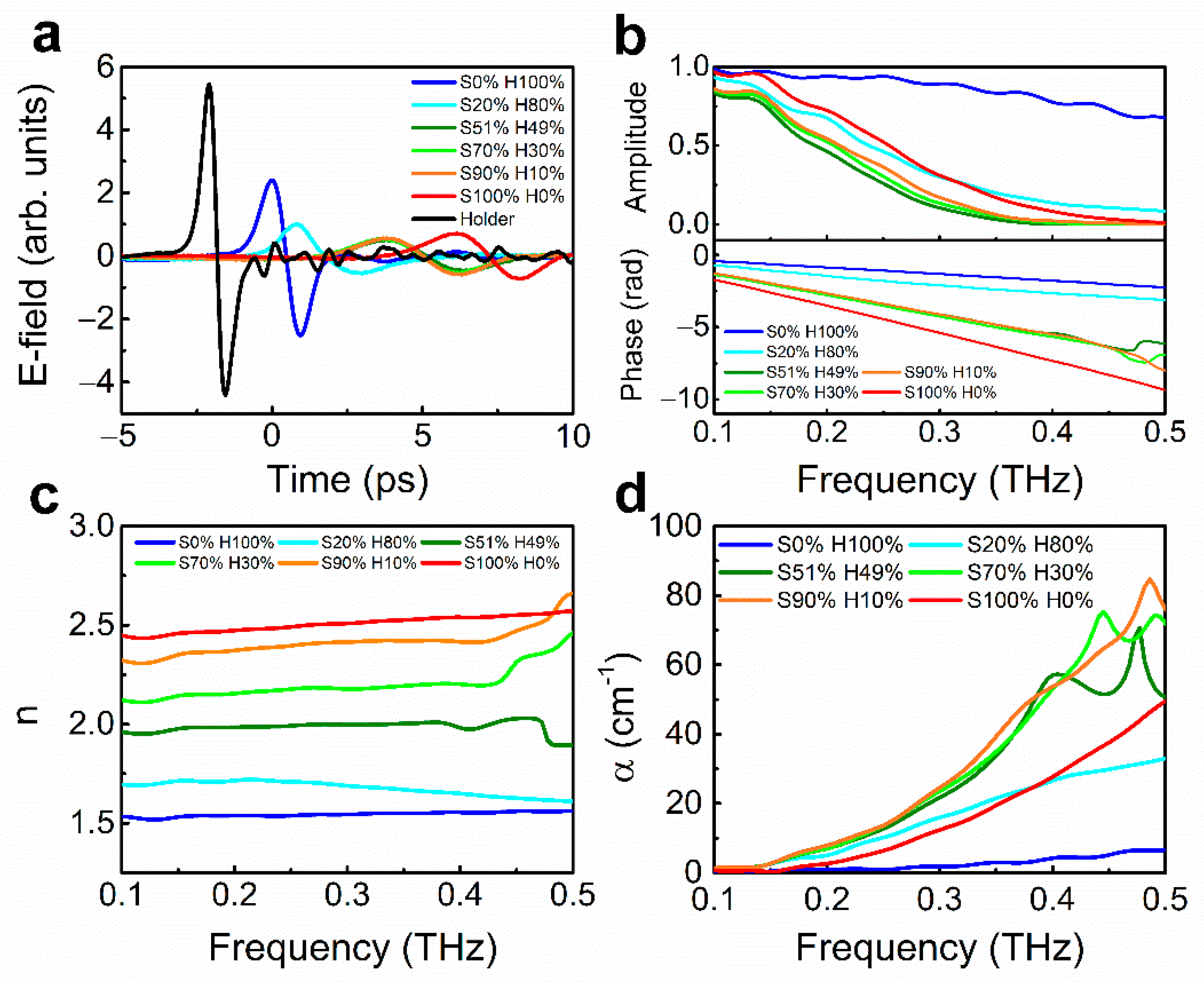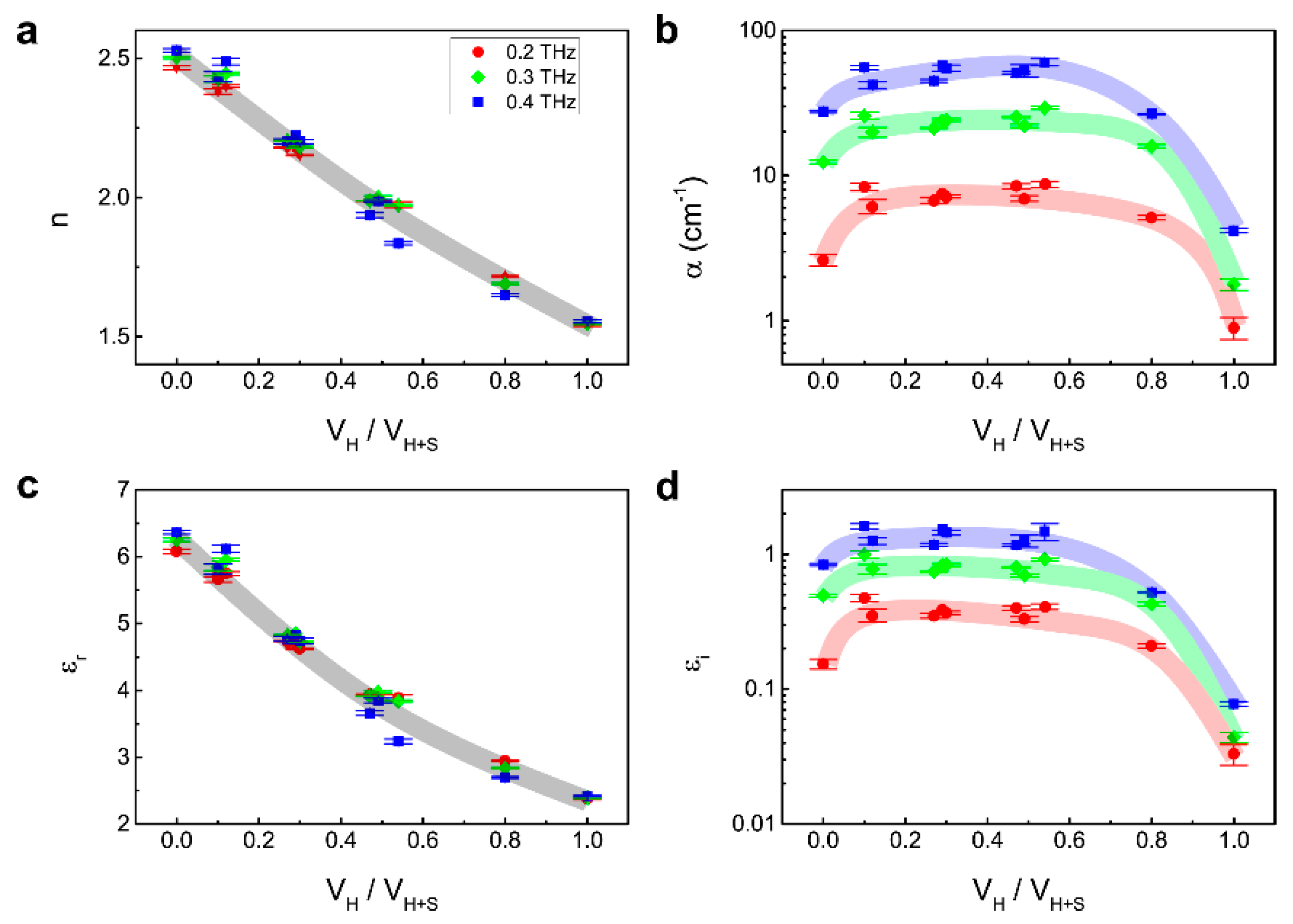Detection of Microplastic in Salts Using Terahertz Time-Domain Spectroscopy
Abstract
:1. Introduction
2. Materials and Methods
2.1. Preparation of HDPE, Table Salts, and the Mixture
2.2. Measurement and Analysis for Terahertz Time-Domain Spectroscopy
3. Results and Discussion
4. Conclusions
Author Contributions
Funding
Institutional Review Board Statement
Informed Consent Statement
Data Availability Statement
Acknowledgments
Conflicts of Interest
References
- Zhang, Y.; Kang, S.; Allen, S.; Allen, D.; Gao, T.; Sillanpää, M. Atmospheric microplastics: A review on current status and perspectives. Earth-Sci. Rev. 2020, 203, 103118. [Google Scholar] [CrossRef]
- Thompson, R.C.; Olson, Y.; Mitchell, R.P.; Davis, A.; Rowland, S.J.; John, A.W.G.; McGonigle, D.; Russell, A.E. Lost at Sea: Where Is All the Plastic? Science 2004, 304, 838. [Google Scholar] [CrossRef] [PubMed]
- Ragusa, A.; Svelato, A.; Santacroce, C.; Catalano, P.; Notarstefano, V.; Carnevali, O.; Papa, F.; Rongioletti, M.C.A.; Baiocco, F.; Draghi, S.; et al. Plasticenta: First evidence of microplastics in human placenta. Environ. Int. 2021, 146, 106274. [Google Scholar] [CrossRef]
- Dris, R.; Gasperi, J.; Rocher, V.; Saad, M.; Renault, N.; Tassin, B. Microplastic contamination in an urban area: A case study in Greater Paris. Environ. Chem. 2015, 12, 592–599. [Google Scholar] [CrossRef]
- Mason, S.A.; Welch, V.G.; Neratko, J. Synthetic Polymer Contamination in Bottled Water. Front. Chem. 2018, 6, 407. [Google Scholar] [CrossRef] [Green Version]
- Zhang, Q.; Xu, E.G.; Li, J.; Chen, Q.; Ma, L.; Zeng, E.Y.; Shi, H. A Review of Microplastics in Table Salt, Drinking Water, and Air: Direct Human Exposure. Environ. Sci. Technol. 2020, 54, 3740–3751. [Google Scholar] [CrossRef]
- Roch, S.; Brinker, A. Rapid and Efficient Method for the Detection of Microplastic in the Gastrointestinal Tract of Fishes. Environ. Sci. Technol. 2017, 51, 4522–4530. [Google Scholar] [CrossRef] [PubMed]
- Costa, C.Q.V.; Cruz, J.; Martins, J.; Teodósio, M.A.A.; Jockusch, S.; Ramamurthy, V.; Da Silva, J.P. Fluorescence sensing of microplastics on surfaces. Environ. Chem. Lett. 2021. [Google Scholar] [CrossRef]
- Yang, D.; Shi, H.; Li, L.; Li, J.; Jabeen, K.; Kolandhasamy, P. Microplastic Pollution in Table Salts from China. Environ. Sci. Technol. 2015, 49, 13622–13627. [Google Scholar] [CrossRef] [PubMed]
- Peixoto, D.; Pinheiro, C.; Amorim, J.; Oliva-Teles, L.; Guilhermino, L.; Vieira, M.N. Microplastic pollution in commercial salt for human consumption: A review. Estuar. Coast. Shelf Sci. 2019, 219, 161–168. [Google Scholar] [CrossRef]
- Lusher, A.L.; Welden, N.A.; Sobral, P.; Cole, M. Sampling, isolating and identifying microplastics ingested by fish and invertebrates. Anal. Methods 2017, 9, 1346–1360. [Google Scholar] [CrossRef] [Green Version]
- Li, Q.; Wu, J.; Zhao, X.; Gu, X.; Ji, R. Separation and identification of microplastics from soil and sewage sludge. Environ. Pollut. 2019, 254, 113076. [Google Scholar] [CrossRef] [PubMed]
- Lee, J.; Chae, K.J. A systematic protocol of microplastics analysis from their identification to quantification in water environment: A comprehensive review. J. Hazard. Mater. 2021, 403, 124049. [Google Scholar] [CrossRef] [PubMed]
- He, D.; Zhang, X.; Hu, J. Methods for separating microplastics from complex solid matrices: Comparative analysis. J. Hazard. Mater. 2020, 409, 124640. [Google Scholar] [CrossRef] [PubMed]
- Ruggero, F.; Gori, R.; Lubello, C. Methodologies for Microplastics Recovery and Identification in Heterogeneous Solid Matrices: A Review. J. Polym. Environ. 2020, 28, 739–748. [Google Scholar] [CrossRef]
- Scheller, M.; Jansen, C.; Koch, M. Analyzing sub-100-μm samples with transmission terahertz time domain spectroscopy. Opt. Commun. 2009, 282, 1304–1306. [Google Scholar] [CrossRef]
- Li, Y.; Yao, J.; Nie, P.; Feng, X.; Liu, J. An effective method for the rapid detection of microplastics in soil. Chemosphere 2020, 128696. [Google Scholar] [CrossRef]
- Iri, A.H.; Shahrah, M.H.A.; Ali, A.M.; Qadri, S.A.; Erdem, T.; Ozdur, I.T.; Icoz, K. Optical detection of microplastics in water. Environ. Sci. Pollut. Res. 2021. [Google Scholar] [CrossRef] [PubMed]
- Zhan, H.; Chen, R.; Miao, X.; Li, Y.; Zhao, K.; Hao, S.; Chen, X. Size Effect on Microparticle Detection. IEEE Trans. Terahertz Sci. Technol. 2018, 8, 477–481. [Google Scholar] [CrossRef]
- Wietzke, S.; Jansen, C.; Rutz, F.; Mittleman, D.M.; Koch, M. Determination of additive content in polymeric compounds with terahertz time-domain spectroscopy. Polym. Test. 2007, 26, 614–618. [Google Scholar] [CrossRef]
- Chan, W.L.; Deibel, J.; Mittleman, D.M. Imaging with terahertz radiation. Rep. Prog. Phys. 2007, 70, 1325–1379. [Google Scholar] [CrossRef]
- Ferguson, B.S.; Wang, S.; Zhong, H.; Abbott, D.; Zhang, X.-C. Powder retection with T-ray imaging. Terahertz Mil. Secur. Appl. 2003, 5070, 7–16. [Google Scholar]
- Withayachumnankul, W.; Ferguson, B.; Rainsford, T.; Mickan, S.P.; Abbott, D. Simple material parameter estimation via terahertz time-domain spectroscopy. Electron. Lett. 2005, 41, 800–801. [Google Scholar] [CrossRef] [Green Version]
- Wietzke, S.; Jansen, C.; Krumbholz, N.; Peters, O.; Vieweg, N.; Jördens, C.; Scheller, M.; Romeike, D.; Jung, T.; Reuter, M.; et al. Terahertz Spectroscopy: A Powerful Tool for the Characterization of Plastic Materials. In Proceedings of the 2010 10th IEEE International Conference on Solid Dielectrics, Potsdam, Germany, 4–9 July 2010; pp. 1–4. [Google Scholar]
- Jin, Y.S.; Kim, G.J.; Jeon, S.G. Terahertz dielectric properties of polymers. J. Korean Phys. Soc. 2006, 49, 513–517. [Google Scholar]
- Piesiewicz, R.; Jansen, C.; Wietzke, S.; Mittleman, D.; Koch, M.; Kürner, T. Properties of building and plastic materials in the THz range. Int. J. Infrared Millim. Waves 2007, 28, 363–371. [Google Scholar] [CrossRef]
- Scheller, M.; Wietzke, S.; Jansen, C.; Koch, M. Modelling heterogeneous dielectric mixtures in the terahertz regime: A quasi-static effective medium theory. J. Phys. D Appl. Phys. 2009, 42, 065415. [Google Scholar] [CrossRef]
- Bardon, T.; May, R.K.; Taday, P.F.; Strlič, M. Influence of Particle Size on Optical Constants from Pellets Measured with Terahertz Pulsed Spectroscopy. IEEE Trans. Terahertz Sci. Technol. 2016, 6, 408–413. [Google Scholar] [CrossRef] [Green Version]
- Ji, T.; Zhang, Z.; Chen, M.; Xiao, T. Far-Infrared Characteristics of NaCl and Alkali Halide. In International Symposium on Photoelectronic Detection and Imaging 2013: Terahertz Technologies and Applications; International Society for Optics and Photonics: Washington, WA, USA, 2013; Volume 8909, p. 89090Z. [Google Scholar]
- Dube, D.C.; Parshad, R. Study of Landau-Lifshitz-Looyenga’s formula for dielectric correlation between powder and bulk. J. Phys. D Appl. Phys. 1970, 3, 677–684. [Google Scholar] [CrossRef]
- Nelson, S.O. Measurement and calculation of powdered mixture permittivities. IEEE Trans. Instrum. Meas. 2001, 50, 1066–1070. [Google Scholar] [CrossRef] [Green Version]
- Bandyopadhyay, A.; Sengupta, A.; Barat, R.B.; Gary, D.E.; Federici, J.F.; Chen, M.; Tanner, D.B. Effects of scattering on THz spectra of granular solids. Int. J. Infrared Millim. Waves 2007, 28, 969–978. [Google Scholar] [CrossRef]
- Lee, G.J.; Kim, S.; Kwon, T.H. Effect of Moisture Content and Particle Size on Extinction Coefficients of Soils Using Terahertz Time-Domain Spectroscopy. IEEE Trans. Terahertz Sci. Technol. 2017, 7, 529–535. [Google Scholar] [CrossRef]
- Kaushik, M.; Ng, B.W.H.; Fischer, B.M.; Abbott, D. Terahertz scattering by granular composite materials: An effective medium theory. Appl. Phys. Lett. 2012, 100, 2012–2015. [Google Scholar] [CrossRef] [Green Version]
- Nazarov, R.; Zhang, T.; Khodzitsky, M. Effective medium theory for multi-component materials based on iterative method. Photonics 2020, 7, 113. [Google Scholar] [CrossRef]
- Scheller, M.; Jansen, C.; Koch, M. Applications of Effective Medium Theories in the Terahertz Regime. In Recent Optical and Photonic Technologies; IntechOpen: London, UK, 2010. [Google Scholar]
- Cherkasova, O.P.; Nazarov, M.M.; Konnikova, M.; Shkurinov, A.P. THz Spectroscopy of Bound Water in Glucose: Direct Measurements from Crystalline to Dissolved State. Biomed. Opt. Express 2018, 9, 2266–2276. [Google Scholar] [CrossRef]
- Koral, C.; Fantauzzi, M.; Imparato, C.; Papari, G.P.; Silvestri, B.; Aronne, A.; Andreone, A.; Rossi, A. Defects in the Amorphous-Crystalline Evolution of Gel-Derived TiO2. J. Phys. Chem. C 2020, 124, 23773–23783. [Google Scholar] [CrossRef]
- Borovkova, M.; Khodzitsky, M.; Demchenko, P.; Cherkasova, O.; Popov, A.; Meglinski, I. Terahertz time-domain spectroscopy for non-invasive assessment of water content in biological samples. J. Infrared Millim. Terahertz Waves 2020, 41, 1057–1068. [Google Scholar] [CrossRef] [PubMed] [Green Version]
- Hernandez-Cardoso, G.G.; Singh, A.K.; Castro-Camus, E. Empirical comparison between effective medium theory models for the dielectric response of biological tissue at terahertz frequencies. Appl. Opt. 2020, 59, 6–11. [Google Scholar] [CrossRef]
- Koral, C.; Ortaç, B.; Altan, H. Terahertz Time-Domain Study of Silver Nanoparticles Synthesized by Laser Ablation in Organic Liquid. IEEE Trans. Terahertz Sci. Technol. 2016, 6, 525–531. [Google Scholar] [CrossRef] [Green Version]
- Dadrasnia, E.; Lamela, H. Optical and electrical characterization of carbon nanotubes by terahertz spectroscopy: Comparison between modeling and experimental results. Proc. SPIE 2011, 8096, 80963. [Google Scholar]




Publisher’s Note: MDPI stays neutral with regard to jurisdictional claims in published maps and institutional affiliations. |
© 2021 by the authors. Licensee MDPI, Basel, Switzerland. This article is an open access article distributed under the terms and conditions of the Creative Commons Attribution (CC BY) license (https://creativecommons.org/licenses/by/4.0/).
Share and Cite
Im, J.; Goo, T.; Kim, J.; Choi, S.; Hong, S.J.; Bahk, Y.-M. Detection of Microplastic in Salts Using Terahertz Time-Domain Spectroscopy. Sensors 2021, 21, 3161. https://doi.org/10.3390/s21093161
Im J, Goo T, Kim J, Choi S, Hong SJ, Bahk Y-M. Detection of Microplastic in Salts Using Terahertz Time-Domain Spectroscopy. Sensors. 2021; 21(9):3161. https://doi.org/10.3390/s21093161
Chicago/Turabian StyleIm, Jaeseung, Taewon Goo, Jugyoung Kim, Soobong Choi, Sung Ju Hong, and Young-Mi Bahk. 2021. "Detection of Microplastic in Salts Using Terahertz Time-Domain Spectroscopy" Sensors 21, no. 9: 3161. https://doi.org/10.3390/s21093161





